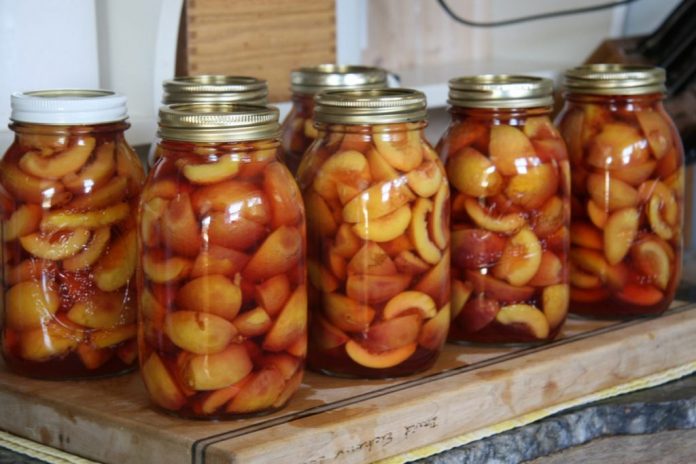MANHATTAN, Kan. — Seasonal fruits and vegetables typically cost less, so it’s easy to understand why cost-conscious consumers are embracing home food preservation.
But Karen Blakeslee, a Kansas State Research and Extension food scientist and frequent county and state fair judge of home food preservation, has seen her share of food safety mistakes.
Such mistakes can cause foodborne illnesses — and be life threatening.
Follow directions
Novices can be successful, she said, but it’s important for both new and more experienced home food preservationists to choose tested recipes and follow directions exactly. New and improved equipment and recommended techniques can simplify the process.
The basics
Blakeslee noted that safe home food preservation typically involves canning, freezing or drying. Recommendations for the three methods have similarities, such as:
- Start with a clean kitchen. Wash hands frequently. Clean as you go to prevent cross contamination.
- Start with good food. Select fresh fruits and vegetables that are free of insect damage, nicks, bruises, and mold.
- Read the recipe in advance, and make sure all ingredients and equipment are on hand.
- Allow time to complete the process. Home food preservation requires staying in the kitchen, on task.
Not all cooktops the same
Blakeslee advises following the canner manufacturer’s recommendations and reading the manufacturer’s instructions for using a smooth top electric range or cooktop with canning equipment.
That’s important, she said, as some smooth top cooking surfaces are not recommended for home canning because the weight of a canner can crack the glass cook top.
A little science
Home food preservationists should become familiar with the properties of the food because food content will dictate preservation methods, the food scientist said.
She cited the differences in recommendations for canning low-acid foods and foods with a higher acid content:
Low-acid foods, such as meats and vegetables, require pressure canning to achieve a safe, recommended processing temperature (240 degrees F) to reduce potential risks of botulism that can grow in improperly canned low-acid foods.
Check equipment
Pressure canners require an investment, but can be used for several seasons when used and cared for according to manufacturer’s directions, which vary with the type of gauge.
A pressure canner with a dial gauge should be checked for accuracy annually because a variance of 1 pound (up or down) can increase the risk of food-borne illness.
Gaskets, seals and vent holes also should be checked annually, said Blakeslee.
A pressure canner with a weighted gauge can be easier to maintain, as only the gaskets (which should be clean and pliable) and general condition will typically need to be checked each year. While generally cost-conscious, she does not recommend buying a pressure canner at a garage sale, thrift store or auction, as “you won’t know its history, how it has been cared for, and may not be able to buy replacement parts.”
Water bath
High acid foods, such as fruits, fruit products, jams, jellies, pickles and tomatoes should be processed in a boiling water bath (212 degrees F), which requires a large kettle equipped with a rack to position the jars off the bottom of the pan.
“If jars are not placed in a rack and come in direct contact with the bottom of a kettle during the canning process, jars may crack and compromise food safety and quality,” Blakeslee said.
“The jar and the intended preserved product will need to be discarded.”
Either way, after following the recipe exactly, freshly canned products should be lifted from the canner with a wire jar lifter, and placed on a wire rack to cool. Lids will “ping” during the cooling process to signal the jar has sealed.
The right jar
Consumers also are advised to choose a jar suited for their intended food preservation method. Jessica Piper, spokesperson for Jarden Home Brands (which produces Ball, Kerr and Golden Harvest canning jars), said canning jars with straight sides can typically be used for canning and freezing.
Canning jars that have “shoulders” are not freezer safe.
New lids should be purchased each year; canning jars with smooth rims (free from nicks and chips) and screw-on rings free of rust can be re-used from year to year.
Avoid fads
Blakeslee reminded that former and sometimes faddish home canning methods increase food safety risks and are not recommended.
Examples include:
- Open-kettle canning, in which foods are cooked and then spooned into sterilized jars but not processed with a hot water bath, cannot ensure food safety.
- Oven canning, either in a conventional or microwave oven, is dangerous. Jars are not made for dry heat and can crack. Oven temperature varies. Oven heat is a dry heat that is slow in penetrating into jars of food.
- Sun canning, in which foods are placed in sterilized jars in sunlight in varying temperatures, but not processed at temperatures high enough to kill potentially harmful foodborne microorganisms can increase food safety risks.
- Processing canned foods in a dishwasher, in which water temperature is not high enough to kill potentially harmful foodborne microorganisms, also can increase food safety risks.
Washing and sterilizing canning jars in the dishwasher prior to use, however, can be effective — and convenient.
Blakeslee recommends labeling and dating home preserved foods and using them within one year.











